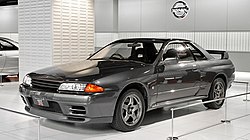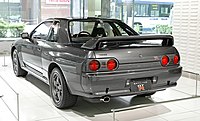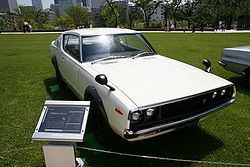Type E (2004)
A limited run (only 5 units) called the Type E was produced in Japan in order to meet homologation requirements to compete in the Super GT series. The Type-E featured a longer nose and rear overhang as well as a few extra aerodynamic aids.
Engine is rated at 206 kW (280 PS) @ 6200 rpm, 363 N·m (37.0 kgf·m) @ 4800 rpm [7]
Gran Turismo 4 Limited Edition
Set for limited release Spring 2009 only in Europe, Nissan 350Z Gran Turismo 4 Limited Edition will feature the Nissan 350Z, in Sunshine Yellow and Black body colors, as its focus. Only 700 copies of this collectors' item will be released. The unique coupe with 3.5 liter engine has now 300hp (20hp more than original) at 6400rpm, but the red line starts at 7000rpm. [8]
35th Anniversary Edition (2005)
To commemorate the 35th anniversary of the début of Datsun 240Z, Nissan released a tuned version of the 350Z coupe. The 35th Anniversary Z was débuted at the Specialty Equipment Marketing Association (SEMA) Show in Las Vegas on November 2nd, followed by its first public appearance at the Miami Auto Show in early November. It went on sale in January 2005.[9]
35th Anniversary Edition includes an uprated 300 hp (220 kW) V6 engine for the 6-speed manual transmission model. Other key 35th Anniversary Z equipment (standard on both 6-speed manual and 5-speed automatic equipped versions) includes unique 18-inch (460 mm) cast aluminium-alloy wheels, front and rear spoilers, Brembo brakes and special Z badging. The car comes in a variety of unique colours including "Ultra Yellow", "Super Black" body colours.
ST Type G (2006)
In 2006-01-12, Nissan announced the sale of ST Type G for Japanese market. This version features 19 inches (480 mm) rear tires (245/40R18 93W front, 265/35R19 94W rear), front & rear fender mouldings (+25mm), RAYS alloy wheels, and exclusive interior leather color.
The ST Type G cost 4,273,500 yen for 6 speed manual, and 4,326,000 yen for 5 speed automatic.[10]
GT-S
During the 2006 Goodwood Festival of Speed, Nissan Technical Centre Europe (NTCE) unveiled the 350Z GT-S concept.[11] The GT-S featured a unique radial flow supercharger (that could be turned on or off via a switch on the dashboard), raising engine output to 382.6 bhp (285.3 kW) and 424.8 Nm without modifications to the engine components. The car also featured new body kit for more cooling and downforce and wider 245 and 265/40/18 tires. No plans for production have been revealed, although there have been some hints that the package may be offered as an upgrade kit. The car has been tested favourably against its possible production rivals, the Porsche Cayman S and BMW Z4 M.[12]
Auto Express magazine reported the GT-S would be on sale in UK for £36,000, but it has yet to be produced.[13]
NISMO Editions
Nissan's performance tuning division, NISMO, began producing modified versions of the 350Z shortly after its introduction, although in the UK these were only available one year after the car was launched.[citation needed]
NISMO R-Tune (2004)
The R-Tune was introduced into the NISMO line-up with modifications including headers, cams, pulleys. The R-Tune voids the Nissan factory warranty,[citation needed] but gains significant horsepower, intended for track racers.
Engine is rated 305 hp (227 kW)
NISMO S-Tune GT (2005)

Modified Nissan 350Z S-Tune GT at the 2006 Kuala Lumpur International Motor Show
The S-Tune GT was released by NISMO to celebrate its success in motorsport, particularly in the Super GT series. The S-Tune GT featured revised long nose bodywork as in the Type-E, a modified version of the VQ35DE engine called the S1 with more power (300 PS / 221 kW / 296 hp) and higher redline (7200 rpm), as well as a sportier NISMO suspension.
20 were produced each month in Japan. Although Nissan did not officially sell S-Tune in UK, Nissan Motor (GB) Ltd. imported 1 S-Tune GT to UK[14]
NISMO 380RS (Nismo 350Z - 2007-Present)
This edition of the 350Z Coupe debuted in New York International Auto Show on April 4, 2007. This version featured the same engine as the regular 350Z (VQ35HR), but produces 313 HP (Redline at 7500 rpm of full 9000rpm) for both 5-speed automatic and 6-speed manual transmission. The car featured NISMO aerodynamics package based on the Super GT championship car, which included an aggressive front fascia with chin spoiler, side skirts, an extended rear fascia with under body diffuser and a rear wing. The car also had NISMO-tuned independent multi-link suspension, Brembo brakes with four-piston front and two-piston rear calipers (with 12.8-inch (330 mm) front and 12.7-inch (320 mm) rear rotors) and NISMO-branded gunmetal grey RAYS alloy wheels (18x9-inch front and 19x10-inch rear with 245/40WR18 front, 265/35WR19 rear Bridgestone Potenza RE050A tires), and NISMO-branded tuned exhaust. All Nismo versions are "Ready For Track" with the safety equipment in it.
NISMO 350Z went on sale in the US in July 2007 at Nissan dealers.[15][16] 1500 were produced for the '07 and '08 model year, and it is assumed that if the demand is there that more will be produced, limited to 10% of all 350Z sales. The vehicle had MSRP of $38,070 for the '07 model year.
NISMO Type 380RS (2007)
Released as the road version for Japanese market of the Type 380RS-Competition race car , it includes the VQ35HR engine stroked and bored to 3.8-litre, rated 257 kW (350 PS/350 hp) @ 7200 rpm and 397 N·m (40.5 kgf·m/293 lbf·ft) @ 4800 rpm torque. Brembo disc brakes are fitted, as are Bridgestone Potenza RE-01R tires (245/40R18 in front, 275/35R19 in the rear) with RAYS wheels. Front and rear dampers come from Yamaha.
NISMO Type 380RS is priced 5.397 million (5.14 million+tax) yen ($38695 USD).[17] Only 300 cars were produced.[18]
NISMO Type 380RS-Competition
It is the race car for which NISMO Type 380RS is based. The 3798 cc engine rated 294 kW (400 PS) at 7500 rpm and 421 Nm (43 kgm) at 5200 rpm torque. This in turn is based on the GT 500 race car that Nissan enters into the Super GT championship.
According to Nissan, the race car cost 26.25 million yen.[19]












